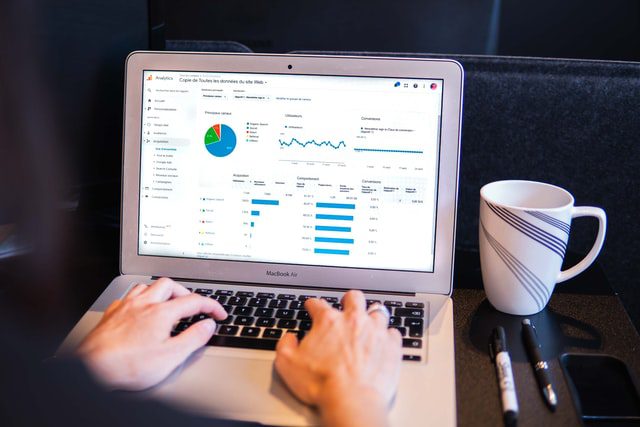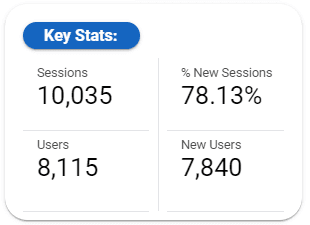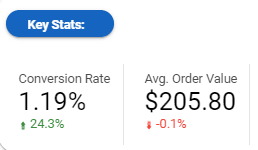
Online sales are expected to grow from 13.6% in 2019 to 19.5% in 2021, an increase of 45.8%. While this growth represents a great opportunity for organizations with a significant online presence, it also presents a curious problem. As business owners and marketers, keeping track of your company’s success, especially in a B2B space that often deals with intangibles like software and services, can be a challenge. When deliverables and service transactions are taking place at scale, it’s tough to find a way to see the bigger picture of where your business stands and where it’s going — which is where B2B Ecommerce metrics come in.
Ecommerce metrics let you track exactly how well your business is doing based on certain predetermined parameters. There are a wide variety of metrics that track different performance measures. These should be analyzed together, rather than in isolation, to get a comprehensive picture of a business’s performance. Here’s why they matter:
- Quantification: Metrics quantify what would otherwise be an intangible characteristic. They turn everyday business performance into hard numbers that can be tracked and charted for future use in planning and business intelligence.
- Planning: B2B Ecommerce metrics aren’t just useful because they tell you what you’re doing right now; they also guide you towards business growth in the future. For example, if a business determines that they’re losing monthly visitors after measuring a certain Key Performance Indicator (KPI), they’ll know they need to switch up their marketing strategy quickly in order to stop the slide. Metrics can be an invaluable tool to find out what your consumers are looking for.
- Motivation: Consistently measuring KPIs and metrics is a fantastic way to keep your team motivated and cognizant of your overall business goals. For example, tracking employee performance through KPIs and rewarding them for exceeding their usual performance can help boost productivity and maintain a positive work environment.
Table of Contents
KPIs and Metrics
Before moving forward, it’s worth noting that while the terms KPI and metric can be used interchangeably, there are distinctions. KPI is a subset of metrics that tracks specific performance indicators, while B2B Ecommerce metrics measure the overall growth of a business or organization.
Metrics That Matter
With the amount of data that businesses accrue on a daily basis, there’s absolutely no end to the number of metrics you can measure. This ends up being a double-edged sword as it can be incredibly easy for businesses to fall into the pit of information and lose sight of which metrics really matter.
B2B buyers are often most interested in a specific subset of metrics, such as cost savings, satisfaction, and productivity. Here are some of the big metrics that B2B ventures should focus on.
Customer Retention Rate

Customer retention rate is the measure of how many customers are still purchasing from your online store. CRR is an important measure of whether or not your Ecommerce capabilities are good enough to maintain a healthy base of repeat customers. If you’re seeing a decline in your CRR metrics or a shift from sales through your online platform to your offline outlets, it could be a sign that your current B2B Ecommerce platform may not be doing enough to satisfy and encourage customers to return.
Spending more on marketing campaigns in order to acquire new customers is almost always more expensive for businesses than it is to retain their existing customer base and encourage them to return and spend more. This is why CRR becomes a critical measure of success for B2B businesses that might not have a more limited pool of loyal customers.
Customer Acquisition Cost

The Customer Acquisition Cost (CAC) is the amount a business spends to acquire new customers. It is calculated by taking the amount spent to acquire new customers against the number of new customers acquired over a given period.
The CAC metric helps B2B Ecommerce businesses gauge the effectiveness of their marketing campaigns and how well the marketing budget is being used. More specifically, you can look at it as the average amount of return the business gets for the amount they’re investing into marketing. A targeted content marketing strategy that can target customer segments with precision can help bring down CAC and establish a larger customer base.

Order Frequency
Order or purchase frequency is the number of orders over a year divided by the number of unique customers a business has. It measures the number of purchases made by a customer over the span of a year. Similar to CRR, purchase frequency is a helpful metric for B2B Ecommerce businesses looking to retain customers and sell complementary products through established channels like email lists and social media.
Average Order Value
Average order value (AOV) is a popular metric that every business should track. As the name might imply, AOV measures the average amount spent by a customer on an individual order, and is calculated by taking the total value of all orders and dividing it by the number of unique orders.
The AOV metric’s importance lies in the fact that it is directly related to a B2B Ecommerce business’s revenue. Rising AOV can be a good sign that your business has a strong remarketing strategy, along with a robust offering of multiple products that appeal to your customer base, rather than a single stand-out product. A decline in AOV indicates that customers might be experiencing growing dissatisfaction or even boredom with your product line, calling for a rethink in what your business offers and how it markets its products.
A common way businesses increase AOV is by incentivizing customers to buy more products with each purchase through product bundles. Product bundles offer customers multiple products at a discount, while still charging a higher price than the customer would have otherwise paid if they had only gotten a single item. Other checkout strategies like discounts if customers spend a certain amount or free delivery above a certain threshold are great ways to increase AOV.
Percentage of Return Visits
The percentage of return visits is a direct indicator of just how well your Ecommerce shopping experience is for new and returning customers. Whether you’re an established business with a strong online presence or a brick-and-mortar organization transitioning to an online B2B Ecommerce model, this metric tells you how ‘sticky’ your website is for buyers.
A healthy or increasing percentage means that your customers are enjoying your user experience and are eager to make repeat purchases. This could be due to a variety of factors, including:
- Navigation: Snappy menus and intuitive navigation through a well-designed website are some of the best ways to create a shopping experience that encourages customers to return. Of the online shoppers in the US, 16% purchase items weekly, and 25% monthly, and they will naturally choose apps and websites that load quickly and are easy to use. Additionally, intelligent use of SEO will make your website visible in search engines, which makes it easy for both new and returning customers to find your website.
- Security: Success in other B2B Ecommerce metrics can come to nothing if your website isn’t secure. A website secured by PCI and HTML5 protocols will provide assurance to new customers that their data is safe, and encourage existing customers to return to a place they know is safe.
- Ordering process: A smooth ordering process is essential to ensure a high percentage of return visits. Customers will be more motivated to return if they know they can expect a snappy ordering pipeline that won’t burden them with repeatedly entering their personal details or annoying pop-ups that ask them to opt into other programs.
Conversion Rate
No conversation about B2B Ecommerce metrics is complete without a mention of the most well-known one: conversion rate. Conversion rates single-handedly drive many marketing campaigns, and for good reason.
Conversion rates are calculated by measuring the total number of visits that ended with a purchase by the overall number of site visits. This ‘visit’ could last hours or seconds; what matters is whether or not there was a purchase before the visitor left your website. This metric measures how effective your business really is.
If you’re seeing low conversion rates, it might not necessarily be a cause for alarm. In 2020, conversion rates in the US averaged out to around 2.57%. While this metric might sound dishearteningly low, B2B businesses need not doubt their Ecommerce model, as there are plenty of ways to improve it, including:
- Website Optimization: Giving your website an overhaul to ensure it loads quickly is a simple yet powerful way to make sure customers make it from one end of the ordering pipeline to the other. An increase of even a second in loading times due to unoptimized pages can lead to a massive increase in bounce rates — the percentage of users who click off of your website. According to Google, as page load times increase from 1 to 10 seconds, the probability of a visitor bouncing hits 123%.
- Know Your Customer: There are certain USPs businesses can use to entice customers to complete their orders. One of these is free shipping information. Letting customers know they’ll benefit from free shipping early on in the ordering process is a great way to nudge them onward.
- CTAs: Implementing better Calls To Action, or CTAs, is usually the first step B2B Ecommerce businesses take when trying to improve their conversion rate metric. More persuasive language and better web design are easy ways to ensure a higher percentage of purchases get completed.

Internal Benchmarks
Aside from the metrics that factor in customer behavior and their relations with sellers, internal benchmarks are important tools that B2B businesses can use to gauge how efficiently their operations are running, under the hood.
- Direct Labor: A measure of how much the business is spending on directly hiring labor for logistics, warehousing, and construction work.
- Fulfillment costs: Fulfillment costs are a relevant benchmarking metric for B2B Ecommerce businesses that supply goods to other businesses and even individuals, whether online or offline. These costs are made up of long-distance logistics charges such as freight and other incidentals.
- Cost per order: Cost per order refers to the amount the business spends to get their product from storage into the hands or devices of consumers. A high cost per order can indicate the business is spending too much on things like freight or labor and is a sign that they can likely expect lower margins.
Internal benchmarking is incredibly important for businesses to perform regularly, as logistics and labor costs can slowly creep up on businesses. If they mount enough, they can drive down the bottom line and even affect marketing budgets, changing how organizations interact with customers.
Metrics for Success
Consistently keeping an eye on Ecommerce metrics is a surefire way for B2B companies to chart a reliable path to success. Follow the Coalition Technologies blog to find out more strategies that help businesses turn knowledge into power with sharp, forward-looking insight.

